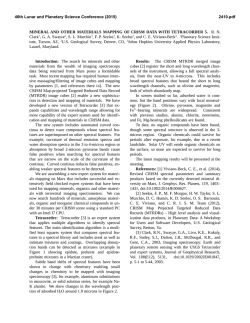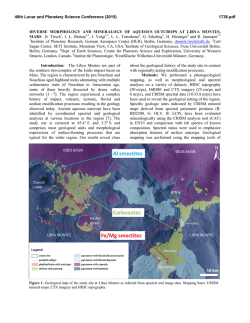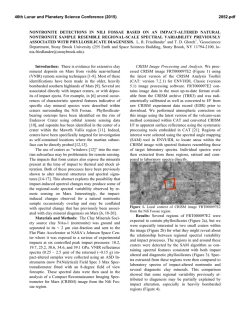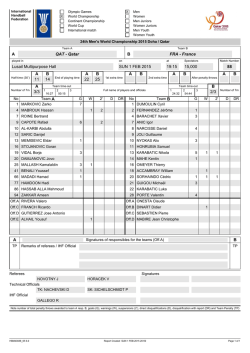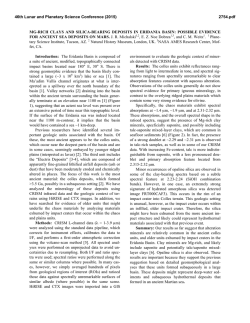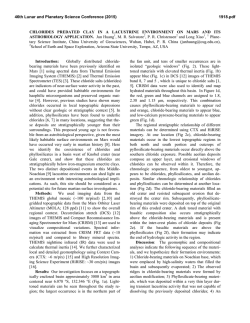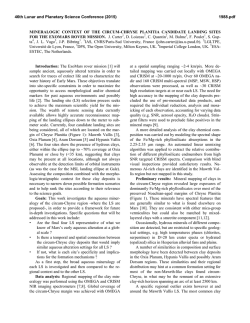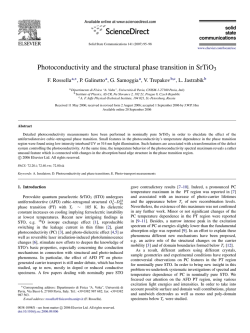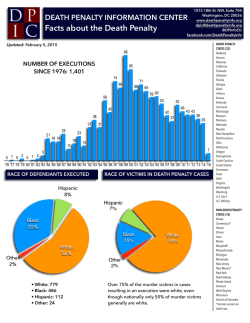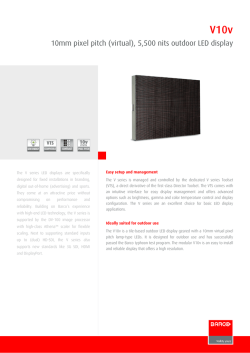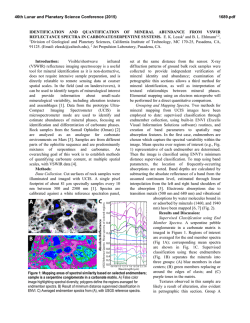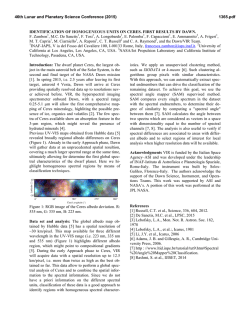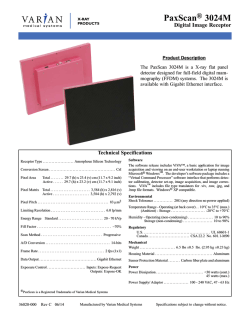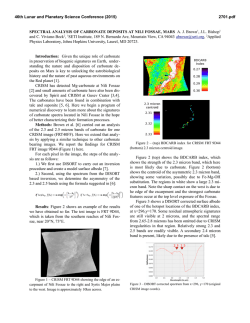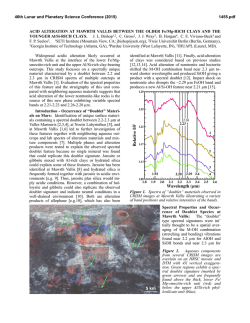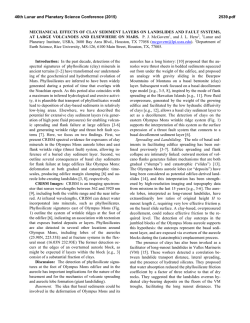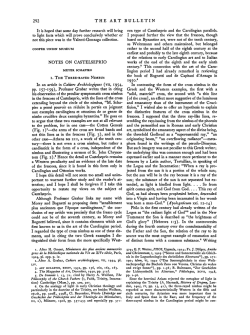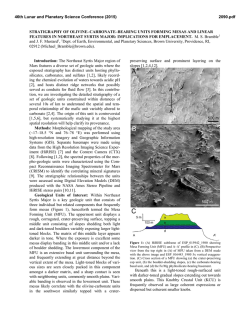
Log-Likelihood Method of Reducing Noise in CRISM Along
46th Lunar and Planetary Science Conference (2015) 1708.pdf LOG-LIKELIHOOD METHOD OF REDUCING NOISE IN CRISM ALONG-TRACK OVERSAMPLED HYPERSPECTRAL IMAGES. C. D. Kreisch1, R. E. Arvidson1, J. A. O’Sullivan1, K. Le1, E. A. Guinness1, D. Politte1, N. Stein1, A. A. Fraeman2 1 Washington University in St. Louis, [email protected], 2California Institute of Technology. Introduction: The Compact Reconnaissance Imaging Spectrometer for Mars (CRISM) on the Mars Reconnaissance Orbiter (MRO) starting in 2010 began acquiring Along-Track Oversampled (ATO) that can be processed to spatial resolutions in the along-track direction of as small as ~9 m/pixel as compared to the normal 18 m/pixel. We present a new method to both process and reduce noise in the ATOs. We pursue processing the CRISM data from spectral radiance files because of known artifacts in standard I/F products. For this work we focus on generation of I/F files in sensor space for the along-track oversampled CRISM observation ATO0002EC79, a scene that the Curiosity rover will be driving into once finished with measuremnts in Pahrump Hills (see Figs. 1,2). DISORT-based processing and the Hapke function are used to retrieve surface single scattering albedos (SSAs), which are free of the effects of aerosols and gases, include time-dependent wavelength shifts, and are independent of lighting and viewing conditions. We developed an iterative log maximum likelihood method with a log hyperbolic cosine penalty function regularization approach to retrieve scene SSA data in the presence of noise [1]. The algorithm produces images with 9 m/pixel spatial resolution from images originally with 18 m/pixel resolution. We compare our results to standard processing of I/F data using map projection capabilities (superGLT) contained within ENVI/IDL. The log-likelihood method reduces Poisson noise in the spectrum for a given hyperspectral pixel, allowing for identification of subtle spectral absorptions otherwise lost in noise. Algorithm Overview: We assume the CRISM ATO data are Poisson distributed with mean μ, where μ is the blurred version of the Martian surface, c. The CRISM ATO data d are the blurred and noisy version of the surface. The spatial and spectral transfer functions (TFs) characterize the blur. We assume the spatial TF is given by a 2D Gaussian and use the asymmetric Gaussian spectral TF given in the CRISM documentation. It is more efficient to maximize the log of a function rather than the function itself, so we compute the image c that maximizes the log-likelihood function for the data. The Kuhn-Tucker conditions describe the requirements for an image c to maximize the loglikelihood function. We begin with an initial guess c0 for the projected, estimated scene c and have the freedom to choose any reasonable output pixel size. For ATO0002EC79 work we chose 9m. The projected image c(k) is mapped into sensor space, where k represents the kth iteration, and the spatial and spectral TFs are convolved with c(k) to obtain an estimate for the measured data. We then divide the ATO d by the simulated scene µ(k) and back project this factor into dimensions of c by using inverses of the TFs. We divide the back projected factor f(k) by H0 + U’ to obtain p(k), where U’ is the derivative of the penalty function U with respect to image pixel c(λ’, x’, y’)(k). Finally, the estimate for c is updated as c(k+1) = c(k)p(k) and the the procedure iterates until convergence is achieved. Penalty Function Motivation and Methodology: When using overlapping measurements with different sampling for the measurements than in the desired final product, noise and systematic errors in measurements can propagate. If there are no direct measurements at a given location, an interpolation strategy is needed. Robust regularization addresses both issues simultaneously. We use a 2D neighborhood penalty in the spatial and 1D penalty in the spectral dimensions. The penalty takes the form of a log hyperbolic cosine function (see Fig. 3). The penalty function is quadratic for small differences and linear for large differences, where size is relative to the chosen function parameters. The effect of this penalty is to introduce smoothing for small differences in values, while allowing larger jumps. This penalty is sometimes referred to as being in the Huber class, motivated by Huber's robust estimation techniques. Results: Preliminary results indicate that the new algorithm sharpens in the spatial dimension and smooths in the spectral dimension relative to the original SSA scene (see Figs. 4,6). For example, the retrieved scene and example linear unmixing end member spectra for L data are shown for third iterations and compared to ENVI-IDL standard superGLT processing in Figs. 5-6. Minor offsets arise from slightly different pixel locations when comparing the projected and unprojected scenes. Fig. 4 compares projected scenes from the 1st and 3rd iterations to ENVI’s superGLT. The alogorithm sharpens spatially as iterations continue and has more sharpening flexibility than standard processing techniques. 46th Lunar and Planetary Science Conference (2015) 1708.pdf References: [1]. O’Sullivan, J. A. et al., (1998), IEEE Trans. Info. Theory, 44, 2094-2123. Fig. 1: Foot print of ATO0002EC79 with Curiosity’s traverse. Curiosity is currently located at Pahrump Hills, base of Mount Sharp, Gale Crater. Fig. 3: Plot of penalty function with δ=0.03, a parameter controlling the transition threshold from quadratic and linear domains. Fig. 2: Sensor space I/F L data cube for ATO0002EC79. R: 2.5295 µm, G: 1.5066 µm, B: 1.0800 µm Fig. 6: End member pectra for units shown in Fig. 5. Large spikes will be removed in ongoing work, using an enhanced penalty function and S data will also be processed using the MLM procedures. Mineralogic interpretations based on comparison to laboratory spectra and predictions will be testable using Curiosity’s instruments. Fig. 5 (below): Projected SSA L data cube 3 iterations with mineralogy map overlain. R: 2.5295 µm, G: 1.5066 µm, B: 1.0800 µm Fig. 4: Portions of projected SSA L data cube for ATO0002EC79. Top image after 1 iteration, middle image after 3 iterations, and bottom image produced from ENVI’s SuperGLT. Images are projected at 9m/pixel and span ~5 km across. R: 2.5295 µm, G: 1.5066 µm, B: 1.0800 µm
© Copyright 2025
